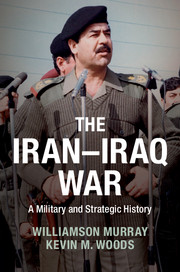Book contents
- Frontmatter
- Dedication
- Contents
- List of figures
- List of tables
- Preface
- Acknowledgments
- Note to reader
- 1 Introduction
- 2 A context of “bitterness and anger”1
- 3 The opponents
- 4 1980: The Iraqi invasion begins
- 5 1981–1982: Stalemate
- 6 Defeat and recovery
- 7 1983–1984: A war of attrition
- 8 1985–1986: Dog days of a long war
- 9 1987–1988: An end in sight?
- 10 Conclusion
- Appendix A Timeline
- Appendix B People
- Appendix C Place names
- Appendix D Order of battle
- Bibliography
- Index
- References
3 - The opponents
Published online by Cambridge University Press: 05 September 2014
- Frontmatter
- Dedication
- Contents
- List of figures
- List of tables
- Preface
- Acknowledgments
- Note to reader
- 1 Introduction
- 2 A context of “bitterness and anger”1
- 3 The opponents
- 4 1980: The Iraqi invasion begins
- 5 1981–1982: Stalemate
- 6 Defeat and recovery
- 7 1983–1984: A war of attrition
- 8 1985–1986: Dog days of a long war
- 9 1987–1988: An end in sight?
- 10 Conclusion
- Appendix A Timeline
- Appendix B People
- Appendix C Place names
- Appendix D Order of battle
- Bibliography
- Index
- References
Summary
The problem is that [the Iranian] leadership does not understand the simplest principles of military action, does not understand the simplest principles of psychology, does not understand the simplest principles of economics, and does not see … they do not have an idea of what defeat means.
– Saddam Hussein, 2 November 1980To understand the difficulties the opposing sides confronted in the Iran–Iraq War, one needs to understand the background of the military institutions of the two states, as well as how the political leaders understood military power and what they expected to gain from the conflict. Not surprisingly, the military institutions and the conduct of the war reflected the significantly different histories, cultures, religious traditions, and political influences of the two nations. Nevertheless, their initial approach to the war was similar: the Iranians emphasized the religious zeal of their soldiers; the Iraqis, the belief that Ba’athist ideology and Arab nationalism would trump other factors.
Ironically, as the war progressed, the challenges confronting the Iraqis forced Saddam to adopt some of the same phrasing and imagery that dominated Khomeini’s approach. The Ba’ath Party tenets of unity, freedom, and socialism soon found themselves augmented after 1981 by calls of Allah akbar (God is Great), for Jihad against the Persians, appeals to Islamic history, references to heroic Iraqi soldiers as Mujahid (holy warrior), and naming the conflict after a chapter in Islamic history, al-Qadisiyya. Even the most iconic of Ba’ath secular organs, the revolutionary command council, took on an additional name as the “leading Mujahid institution” to burnish its Islamic credentials.
- Type
- Chapter
- Information
- The Iran–Iraq WarA Military and Strategic History, pp. 51 - 84Publisher: Cambridge University PressPrint publication year: 2014

